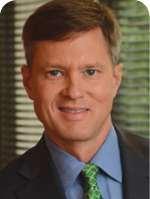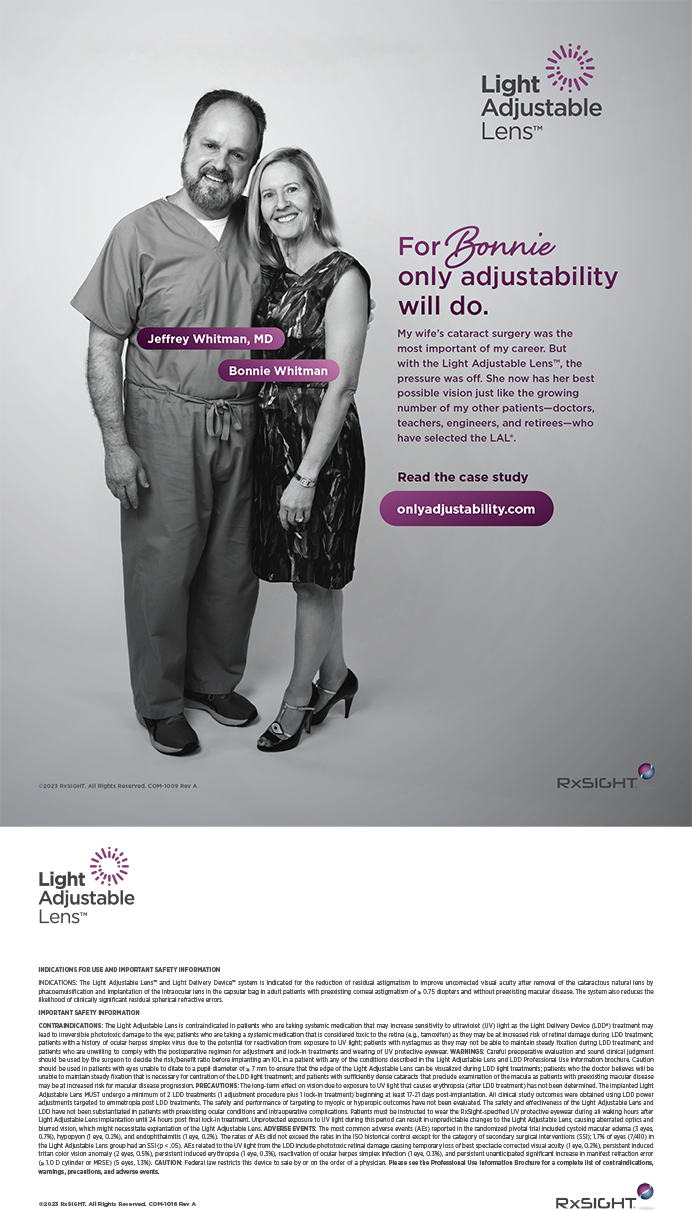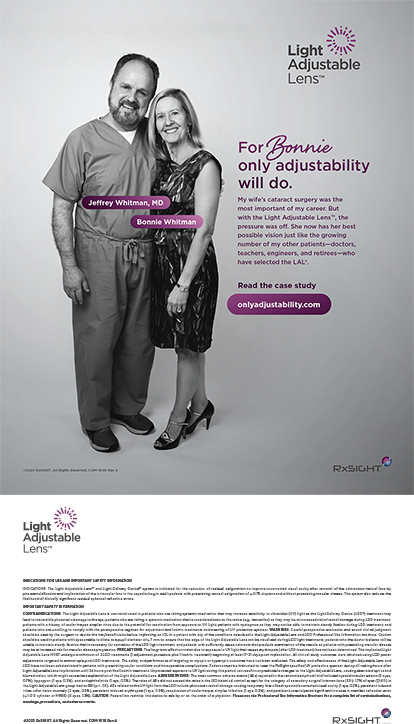
Nashville, Tennessee, may be known for its honky-tonks and country tunes, but the city is also a major hub of health care. Medical companies and health care providers contribute roughly $30 billion annually to the country music capital’s local economy, according to a 2015 economic impact study by the Nashville Health Care Council and Middle Tennessee State University. Nashville’s hearty health care market has spawned a discerning patient population known for its high expectations. These individuals are among those who have helped Loden Vision Centers experience 32% growth over 5 years, which in turn has spurred a major practice expansion.

James Loden, MD, started the solo practice in 1999 after buying out a failing physician practice management company with which he had been affiliated for several years at the start of his career. He took a practice that was doing 300 cataract surgeries and 40 LASIK procedures a year and grew it into the leader that it is today. His solo practice currently does about 4,900 cataract and 1,200 LASIK surgeries annually. Says Dr. Loden, the quick story is that “we continued acquiring, continued growing, moved into larger facilities, started our first LASIK center, started our first [ambulatory surgery center], added a second LASIK center, purchased another practice with a surgery center, and now we’re where we are today with six [ophthalmologists] and four optometrists.”
MAXIMUM CAPACITY
The longer version of the practice’s manifest destiny modus operandi is that, once it hit a certain point of growth, Dr. Loden had to either settle or take a risk. “Between 2013 and 2014, we hit maximum capacity,” he explains. “We had basically 100% market penetration in certain zip codes, so we are increasing infrastructure and also looking at going into different markets to be able to grow.”
Late in 2015, they added a 44,000-square-foot building complete with a boutique LASIK and refractive cataract clinic, a general clinic with optical, and a retina clinic. Optical and retina services are new to the Loden enterprise. Additionally, the second floor houses corporate offices and 10,000 extra square feet of shell space for future expansion—possibly designated for aesthetics. “We were at a crossroads in 2012 with double-digit growth, and then in 2013, we started seeing stagnation,” says Dr. Loden. “I either had to assume the risk of more management, more doctors, and more facility or run a smaller, higher-net practice and commit to being comfortable with that level for the rest of my life. At 50 years old, I felt that I was too young to stagnate, so I decided to go big, and we’ll see how that plays out years from now.”



He points out that going to the next level of expansion takes a tremendous increase in overhead; he anticipates 18 to 24 months of severe overhead crunch. “In order to add multiple new locations and go into these new markets in full force, we’ve had to add managers and physicians,” Dr. Loden explains. “We have to have doctors and staff to cover those markets, even though they are not at full capacity yet, so we have to have the capital to take a 6- to 8-month loss until those are up and running full steam ahead.”
Risk like this, he says, is not for everyone. “To be able to go to the next level, you have to be willing to sign personal guarantees for $5 million,” Dr. Loden comments. “There’s sort of an unwritten understanding that, to go to the next level, you have to be comfortable with risk, personal guarantees, and debt. A lot of people just simply cannot tolerate that. Very few physicians are willing to invest this type of capital. A trait of physicians, accountants, and lawyers is that they like the comfort of having a good, solid, above-national-average salary for their time at work, but they’re very risk averse as a whole.”
Dr. Loden’s Top Tips
When the economy took a nosedive in 2008, and LASIK numbers shriveled nationwide, Dr. Loden went into risk-taking mode and bucked the trend. “We opened a new LASIK center in the part of town where we did not have good market penetration; this area was the highest household income zip code in the state,” Dr. Loden says. The move proved beneficial. “It took $3.5 million to purchase the building, about $500,000 to renovate it for a LASIK center, and then funds to get it up and running—so it was over a $4.5 million endeavor during the middle of the recession,” he recalls. By 2014, Loden Vision Centers did 1,000 LASIK surgeries between its two centers in a single year, and more recently, the practice logged 200 additional LASIK procedures for a total of 1,200 in a 12-month cycle.
Although being the sole owner of Loden Vision Centers means Dr. Loden assumes all of the risk of expansion, it also means that he is able to single-handedly make decisions that he deems best for his practice. “[In] a single-owner practice, I am able to decide, on a dime, what piece of equipment we’re buying and how we’re managing the financing or cash acquisition of equipment,” he remarks. “We don’t have to vote by committee to do things. Nor do we have to consider how that equipment might affect each associate or partner’s revenue, which is a major benefit, especially because sometimes the equipment is in a completely different realm from those who would have input in a group practice. For example, those who do glaucoma or cornea surgery aren’t affected by the LASIK marketing budget. So, I’m able to invest how I see fit, and if that means forfeiting a take-home salary and investing funds into company expansion and growth, I can do that without conferring with anyone. That’s provided me a great deal of flexibility, and one of the major ways we’ve been able to grow is [my] being able to reinvest within the company.”
Dr. Loden explains that he marginalizes his take-home income to just what he needs in order to reinvest in the organization. “The first year I was in practice, for example, once I made the purchase, I took no salary for 6 months and then $30,000 the next 6 months,” he says. “I reinvested everything else in external and internal marketing. By doing that, it jump-started the practice. A lot of people simply don’t have the wherewithal to do that. You have to be willing to sacrifice personally to obtain the exponential growth.”
WIDENING THE SCOPE OF SERVICE
Recent expansion into optical and retina services is among the practice’s attempts to answer social and demographic trends, according to Loden Vision’s chief administrative officer, Carolyn Salvato, whose responsibilities include oversight of finance, staffing, and optical, among other things.

Ms. Salvato was an optical industry consultant before joining the Loden team. According to her, more than ever before, optical is a lucrative revenue stream. “If their doctor doesn’t have an optical shop, patients typically don’t go from one private doctor’s office to another private doctor’s office,” she explains. “They typically go to the mall to a chain optical retailer. By adding optical, we’re not cutting into the capture rate of optometrists with whom we comanage.”
Bringing in optical is also about addressing pertinent social and demographic trends. “We are a considerable LASIK practice, and this brings in lots of young people,” she comments. “Now with optical, we are able to service those patients who come in seeking LASIK but are not eligible for it. If someone comes in and … is not a good candidate, we have other options for [him or her] including contact lenses or eyeglasses. Prior to having optical, there was not much more we could do for them beyond an eye exam. Now, we can service them in another way.”
With respect to demographics, being unable to assist patients with retinal issues had become untenable as well. “Bringing in a retinal surgeon and opening a retina clinic isn’t just about expanding our reach,” notes Ms. Salvo. “It’s also about satisfying our patients who want to be able to have all of their eye care needs serviced within one practice.” This is especially true of elderly patients who are diagnosed with retinal conditions, she says: “They don’t want to have to see another doctor at a different practice. I think it’s a relief for the patients that they don’t have to go searching, or we don’t have to find the right doctor for them. Now, everything is here.” Loden Vision Centers also offers laser cataract surgery, refractive lens exchange, and implantable contact lenses to appropriate candidates.
SATISFYING THE SAVVY PATIENT

Loden Vision is much more than a one-stop shop; it is the appropriate venue for patients who have done their homework and know exactly what they want. Sue Henry, chief clinical operating officer, explains that the city’s patients are unique. “Nashville is at the center of health care, with numerous companies based here that focus strictly on [the industry], so the Nashville population is a little more well versed in what they should be looking for in [terms of] health care,” she says. Loden’s typical cash-pay patients have “shopped the doctor” before coming in and have chosen Loden Vision based on what they have learned. “They’re not shopping for price; they’re shopping for outcome and experience,” Ms. Henry comments. “These customers are informed. Here in Nashville, we do LASIK touch-ups on patients who are 20/25. These patients are not happy if they’re plano minus a half.”
Nashville: Health Care Hub
• The health care industry in Nashville, Tennessee, annually contributes an overall economic benefit of nearly $30 billion and more than 210,000 jobs to the local economy.
• Globally, 56 health care companies headquartered in Nashville generate more than $62 billion in revenue and nearly 400,000 jobs.
• More than 250 health care companies have operations in Nashville and work on a multistate, national, or international basis.
• The health care industry is Nashville’s largest and fastest-growing employer, directly employing 110,000 people.
• One in eight Nashville workers is employed by a health care provider.
In addition to providing the best outcomes, Loden strives to provide the best experience. On the cash-pay refractive side of the practice, that means an attractive, sophisticated ambience worthy of the big-ticket procedures performed there. “We have separate waiting areas for refractive patients and retina patients,” Ms. Henry says. She points out that LASIK patients tend to be relatively young and healthy and that Loden Vision aims to provide an experience that can help these patients justify their financial investment. However, she adds that all patients—not just cash-paying refractive patients—are handled in a way that results in overall satisfaction and positive word-of-mouth referrals.
“Dr. Loden’s philosophy has always been to take care of patients and feel good about what he does,” says Ms. Henry. “For example, even when he has to turn a patient away because [he or she is] not a good candidate for LASIK, he relays the information in a way that lets [him or her] know it’s a good, honest opinion.”
The best technology and aesthetically appealing and accommodating facilities are important for tending to the ophthalmic needs of Nashville’s knowledgeable patients. The success and longevity of Loden Vision Centers, however, comes down to decent, principled care. Dr. Loden says he conducts all of his affairs in a way that makes him comfortable bumping into patients when he is out to dinner with his family. He states, “I don’t want to be someone who has to whisk my wife away for fear that a disgruntled patient will approach us. When patients see me around town, I want them to say, ‘Hey, there’s Dr. Loden’ and be happy when they say it. That’s why I’m still here almost 20 years later and [why] we’re growing the way we are.” n
Rochelle Nataloni
• freelance medical writer with 25 years’ experience specializing in eye care, aesthetics, and practice management
• (856) 401-8859; rochellemedwriter@gmail.com; Twitter @JustRochelleN; www.linkedin.com/in/rochellenataloni


